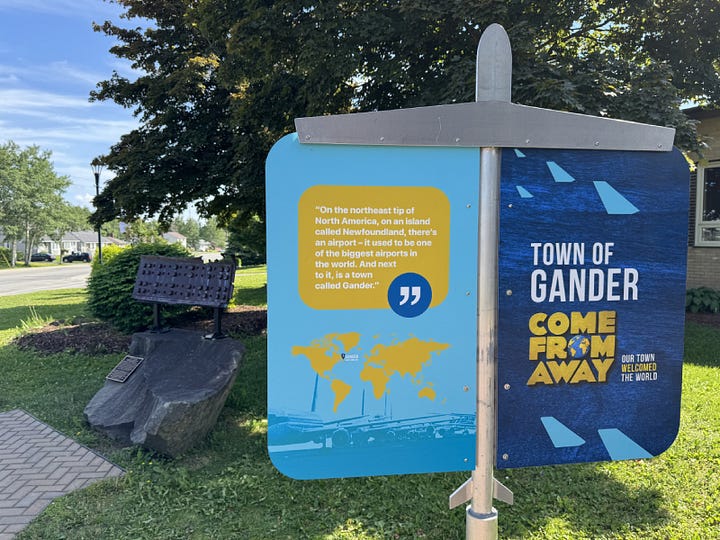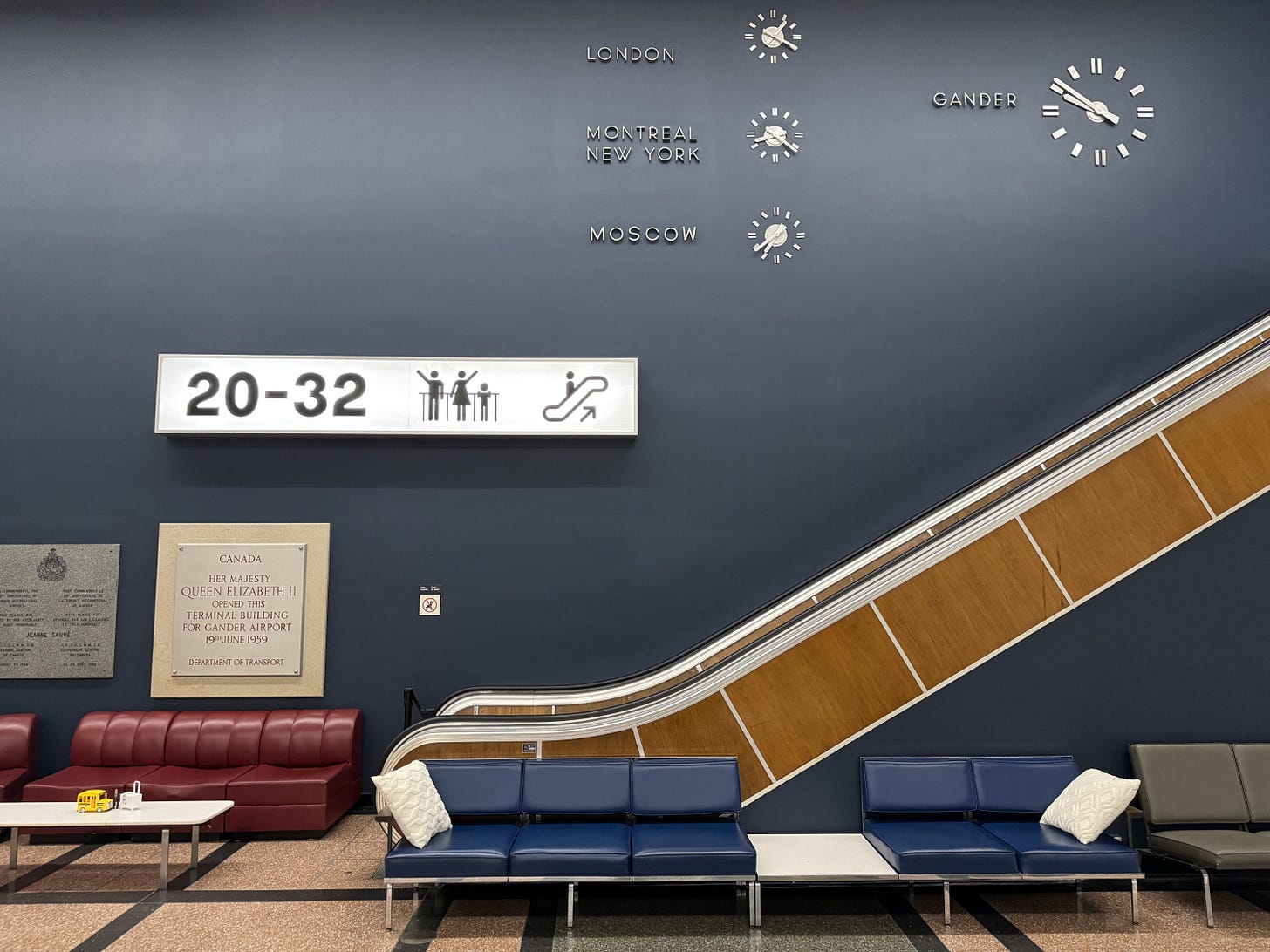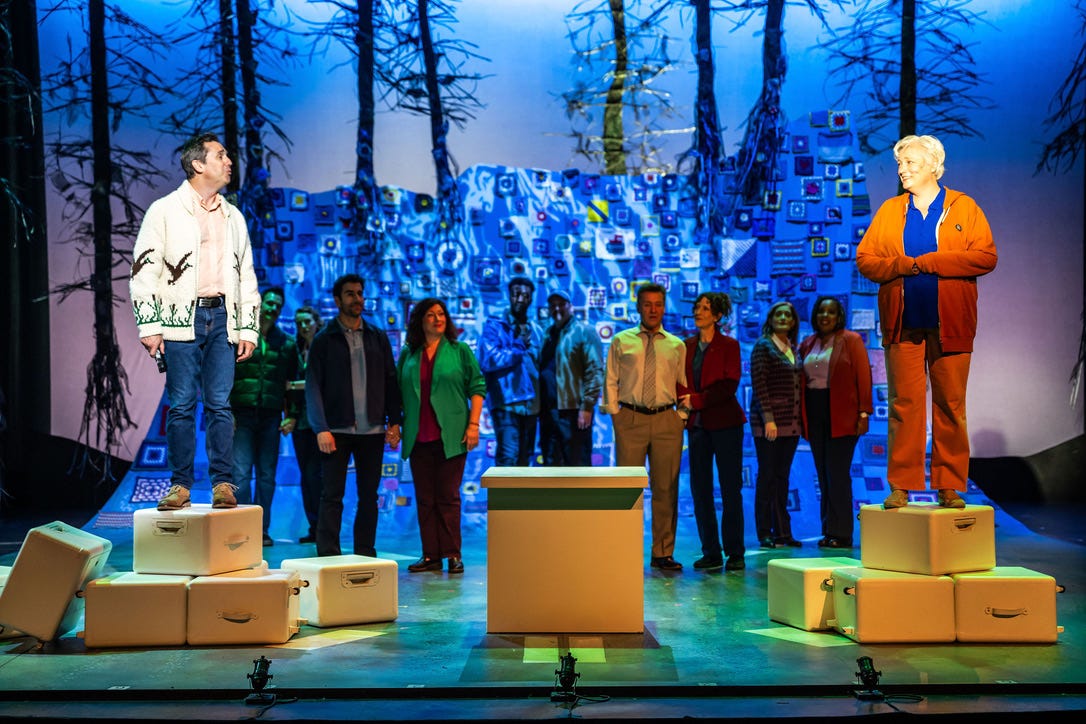HOW COME FROM AWAY CAME HOME
I went to Gander to see the hometown production that's angling to become a summertime staple in Newfoundland
Welcome to your weekly guide to the global theater industry. New to Jaques? Check out this handy explainer.

If you’ve seen the musical Come From Away, you’ll remember the high-spirited sequence in which several of the airline passengers stranded in the small town of Gander, Newfoundland, head over to the local legionnaires’ club to down a shot, don a bright yellow sou’wester, and kiss a fish as part of a tongue-in-cheek ritual that anoints the out-of-towners as Newfoundlanders.
If you see the show in Gander, where the musical is now playing for the third summer in a row, then you can head over to the real-life Royal Canadian Legion Branch #8—just like I did one Saturday night earlier this month. There I was ceremoniously served a shot of the regionally beloved rum known as Screech by Claude Elliot himself, the former town mayor who’s one of the many locals depicted in the musical.
I didn’t end up kissing a fish, but every night the actors in the show do—and unlike on Broadway, they use a real fish in the Gander production. (For authenticity!) It’s a sizeable cod, caught by one of the crew members and kept in a freezer backstage.
Eight years after it opened on Broadway in 2017, Come From Away has circled the globe, playing London, Seoul, Madrid, Tokyo, Buenos Aires, Sydney, and beyond. Just this summer it’s been seen in non-replica productions from Manila to the Muny, the venerable, Tony-winning U.S. regional in St. Louis.
But even as it’s traveling the world, Come From Away has found its way back home to Gander, the Canadian town in a remote part of Newfoundland where residents famously banded together to house, clothe, and feed the ~7,000 international passengers whose flights were unexpectedly grounded in Gander for almost a week in the wake of the Sept. 11 attacks in New York City. The town’s top-class, non-replica production—directed by a Newfoundlander and shepherded by the Canadian producer who steered the show to Broadway—has over the last three years brought to Gander some 15,000 visitors a summer, and with them an attendant boost to the local economy.
“It’s been kind of transformative for us,” Percy Farwell, the current mayor of Gander, tells me. (He was the town’s deputy mayor back in 2001.) “Newfoundland gets a fair amount of tourists looking for whales and icebergs, but none of those are in Gander. This show, and this production, has made us a destination.”
Gander’s staging of Come From Away has become one of the clearest recent case studies of how the theater industry can bring not just cultural value to a locale but real, economic impact. (See also: Starlight Express in Bochum, Germany, now in its 37th year.) And the production’s backers are currently laying the groundwork to make the production an ongoing, annual summertime attraction.
In this SPOTLIGHT STORY, I’ll highlight
how a commercial producer and municipal support made Come From Away’s homecoming happen,
the not-for-profit entity now dedicated to making the show a sustainable annual offering,
the surprising local precedent for an annual theater attraction that draws crowds to a Canadian island,
the Come From Away superfans from all over the world I met during the production’s opening weekend,
how local businesses and the tourism industry are capitalizing on the influx of visitors,
the real-life spots you can visit after seeing the show, and
the literal signs of Come From Away that you see all over town.
GET TO KNOW GANDER
Long before Come From Away put the town on the radar of Broadway lovers around the world, Gander was already steeped in aviation history. Back in the 1950s, when flights over the Atlantic Ocean required a pit stop for refueling, Gander’s airport was home to one of the busiest international airports in the world, a place where everyone from Frank Sinatra to the Queen of England passed through. To this day, the Gander office of Nav Canada remains a major hub for international air traffic control; in 2024, the Gander Flight Information Region managed the air routes of a record 500,000 flights in one calendar year.
The town takes its history seriously. Today, the Gander International Airport Departures Lounge is a meticulously preserved snapshot of midcentury modern chic, with an upstairs museum dedicated to Gander’s place in the annals of aviation. (The lounge also adjoins the local movie theater, a 75-seater that was showing Jurassic World Rebirth the weekend I visited.)
Before the advent of the musical, too, the generosity and hard work of the locals in the immediate wake of 9/11—when the closing of U.S. airspace forced 38 airplanes to land in Gander, nearly doubling the town’s population at the time—had already spawned news coverage and at least one book. The towns of Gander and nearby Appleton received pieces of steel salvaged from the World Trade Center in honor of the region’s humanitarian contributions following the attacks; the remnant in Gander is displayed as part of a Compassion Monument on the lawn of City Hall.
Since its premiere at the La Jolla Playhouse in San Diego, Calif., in 2015, the musical has further raised the profile of Gander and its environs. All around town—at City Hall, at the Royal Canadian Legion, at the Steele Community Center where in 2001 the hockey rink was temporarily converted into what’s described in the musical as “the world’s largest walk-in refrigerator”—are signs adorned with the show’s Broadway branding and commemorating the musical moments that took place there. At the nearby Dover Fault, you can even sit on the bench where a real-life romance blossomed between two stranded airline passengers (depicted in the musical in the song “Stop the World”). Tourists can visit each site like they’re the stations of Come From Away.
And for the third summer in a row, a local production of Come From Away is giving visitors one more reason to come to town.




From my iPhone’s camera roll: A selection of Come From Away signs around Gander, plus the view from the bench where Diane and Nick’s romance blossomed.
FINDING THE FUNDING IN NEWFOUNDLAND
The idea of bringing Come From Away to Gander stretches all the way back to 2013, when the musical was in its earliest phases of development at Sheridan College in Ontario. At the time, Michael Rubinoff—now a prominent Canadian producer working in both the commercial and the not-for-profit sectors—had just launched a new musical theater incubator program at Sheridan, and tapped the writers David Hein and Irene Sankoff to pen a musical chronicling the events in Gander just after 9/11.
Following a 2013 studio staging of Come From Away, Rubinoff addressed an audience watching both live in the room and online via a webcast. “I said, ‘This is not the end for Come From Away. We plan to share this show internationally, and it’s a dream one day to bring a full production to Gander,’” Rubinoff recalls. “Of course I uttered those words having no idea what was ahead of us.”
What was ahead were runs in La Jolla, Seattle, Washington, D.C., and Toronto prior to a 2017 opening on Broadway, where the show scored seven Tony nominations and won one for Christopher Ashley’s direction. A few years later the pandemic interrupted productions on Broadway, on tour, and around the world; in the interim, a pro-shot, filmed version of the New York production made its way to Apple TV+.
In 2022, Come From Away played concert versions in Gander and the Newfoundland city of St. John’s (just over 200 miles away from Gander) as part of Come Home Year, a cultural tourism enhancement program funded by the province of Newfoundland and Labrador. After that, planning for a full, local production accelerated with the Arts and Culture Centre, a division of the Department of Tourism, Culture, Arts and Recreation. ACC operates a network of venues around the province including the 400-seat auditorium in Gander where Come From Away is now playing.
In the first year of a three-year plan for the show, the government of Newfoundland and Labrador paid for the 2023 production through the Arts and Culture Centre. Rubinoff estimates that initial staging cost about $2 million CAD (~$1.5 million USD), including two months of weekly running costs, with that initial outlay offset by revenue from an average ticket price hovering in the range of $100 CAD (~$75 USD). (This year, most tickets in the 400-seat house go for $90 CAD, or ~$65 USD, with a band of primo locations going for $130 CAD or ~$95 USD.)
After that first summer production—with a budget that included one-time, startup expenses like set construction—annuals costs have come down. This year Rubinoff say the show rings in at closer to $1.8 million CAD (~$1.3 million USD) including the running costs for its nine-week run (June 29-Aug. 31). The show received $500,000 CAD (~$365,000 USD) in funding from the government in 2024 and $300,000 CAD (~$220,000 USD) this year.
The town was also instrumental in helping to score a hefty grant from the Atlantic Canada Opportunities Agency, a federal funding body that paid for $600,000 CAD (~$440,000 USD) worth of state-of-the-art sound equipment, which is now owned by the province and used by Come From Away during its run in the Smallwood Theatre.
The town is already seeing ample rewards for its support of the project. “This show has absolutely boosted tourism,” says Fred Hutton, Newfoundland and Labrador’s Minister of Tourism, Culture, Arts and Recreation. “It’s bringing people in from all over the world.”
There’s no real data yet on the exact economic impact of the production, but there’s plenty of anecdotal evidence. The weekend I was in Gander coincided with the province’s Special Olympics, which meant that all five of the town’s hotels were booked solid and restaurant business was brisk. Of the ~15,000 theatergoers per summer that have turned out for the show (with another 15,000 expected this year), Rubinoff estimates that 65% of them come from the province of Newfoundland and Labrador and another 20% from other parts of Canada, with the remaining 15% attracted from all over the world.
I met a number of those international visitors myself when I was in town. At the Royal Legion after a performance I made small talk with Bill Shaddix, an insurance agent from Florida, and his wife Jenny, who were celebrating Bill’s recent retirement with a trip to Gander to see the musical (which Bill had discovered when his enthusiasm for Hamilton prompted Spotify to feed him tunes from Come From Away). At the Legion I also encountered not one but two community theater directors, one from Arbroath, Scotland, and one from Manchester, England, researching their own local stagings of the show. And at the airport I met a flight attendant and superfan from Vancouver who had seen Come From Away, in various iterations around the world, a total of 48 times.
“Invariably people tell me how much they love this production in particular,” Farwell, the mayor, says. “Because they’re experiencing the show in the place where it happened.”
A LOCAL POV ON A WORLDWIDE MUSICAL
At the helm of Gander’s non-replica production of Come From Away is director Jillian Keiley, a Newfoundland native who spent a decade as artistic director of the National Arts Centre English Theatre in Ottawa and now lives in St. John’s.
“It was so important to me to tell the story here from a Gander point of view, because the show really is written from an outsider point of view—and that’s why it works, I think, in a lot of ways,” Keiley says. “But I always tell the cast that we’ve got to have real respect for the Newfoundlanders and the internal battles they fought at the time to get it together and help. We’re real people, not these leprechauns up in the North Atlantic.”
Several members of the production’s ensemble (many of whom are returning to the production after previous summers) hail from Newfoundland, including Petrina Bromley, a member of the original Broadway cast who played SPCA manager Bonnie in New York and now stars as pilot Beverley Bass in Gander. (Another original Broadway cast member, the Canadian actor Astrid Van Wieren, plays Diane in Gander after appearing on Broadway as the Ladies Auxiliary president Beulah.) Alongside the largely Canadian cast, Keiley has also made it a point over the last three years to include at least one New York actor (Darrell Morris Jr. this year) as a nod to the city’s centrality to the events of 9/11.
The show’s set incorporates non-naturalistic takes on the trees that dominate the local landscape, and the spare design of the all-purpose set pieces—a set of white suitcases and tables that fill a number of functions in setting scenes—is inspired by the stylishly minimalist tick marks of the international clocks on the wall of the airport’s Departures Lounge. (When flipped, the tables also resemble the silhouette of the Twin Towers.)
A backdrop showcases a collage of crocheted “granny squares” as a tip of the hat to the local affection for granny-square blankets and afghans—and as a way for audiences to feel, as Keiley likes to say, that Gander has wrapped them in a warm embrace. To further strengthen community investment in the production, the show in its first year asked locals to contribute granny squares for inclusion on the set. Keiley expected to receive about 100; instead they got close to 2,300—so now squares also adorn the entrance and the walls of the auditorium.
This year, after the show’s July 6 opening, the production also regularly began to incorporate brief onstage addresses from real-life community members who were in Gander on 9/11, in part as a reminder that the main characters depicted in Come From Away are just a handful of the thousands of locals with stories to tell about their experiences during that time.
With these first three years of annual productions under their the belt, both the show’s producers and the town have high hopes for a long future life.
“What we’d like to see is for this show to be a centerpiece for a much bigger, seasonal, cultural offering every summer,” Mayor Harwell tells me.

THE ANNE OF GREEN GABLES PRECEDENT
An ongoing musical that draws a reliable stream of summertime tourists to a scenic Canadian island north of Nova Scotia? It turns out Come From Away wouldn’t be the first.
In 1965, a musical adaptation of Anne of Green Gables opened in Charlottetown on Prince Edward Island, the Canadian province where the 1908 novel, a beloved all-ages tale about a plucky orphan, takes place. It ran every summer there until 2019—54 years!—when the pandemic interrupted its record-breaking streak. In 2022 the show returned on an every-other-year schedule.
Along the way, a bustling summertime cultural schedule sprang up around Anne. The Confederation Centre of the Arts, the local institution where Anne of Green Gables plays, also hosts the long-running Charlottetown Musical Festival, commissioning and presenting a slate of shows every summer. (The 2025 lineup includes Million Dollar Quartet and the popular Canadian-born title Tell Tale Harbor.)
There’s even a second, long-running, local musical inspired by the the Anne of Green Gables books. Anne & Gilbert, based on the second and third novels in the series (Anne of Avonlea and Anne of the Island), premiered in 2005 and is now in its 21st year.
Those arts offerings have helped encourage local tour operators and hotels to offer a host of visitor packages—some including tickets to the show(s)—for travelers looking for full immersion in the book’s locale.
It all seems to be working. As noted last year in The Globe and Mail, every year Prince Edward Island’s population of 177,000 explodes to more than 500,000, with 6% of them coming specifically for an Anne experience.
LAYING A FOUNDATION FOR A LONG FUTURE
The enduring economic engine of Anne gives the stewards of Gander’s Come From Away one possible roadmap for success.
In looking ahead, Farwell mentions the Gander Musical Theatre Symposium, which in 2019 brought theater industry pros to town for workshops, panels, showcases, and other professional development events for students and the community. “That’s something we’d like to do regularly,” he says.
And tourist packages organized around the events depicted in Come From Away have already sprung up around town, including a helicopter tour of regional areas of interest.
For Rubinoff, the challenge now lies in finding a model that’s sustainable well into the future. In the show’s second year, he launched a not-for-profit, You Are Here Inc., to produce the show. “The next step is to get charitable funding and build an endowment that, with ticket sales, could support the cost recovery of the project,” he says.
Meanwhile, plans are being laid for the next three-year cycle of annual performances. It’s not lost on anyone that next year marks the 25th anniversary of the events depicted in the show. Don’t be surprised if the 2026 Gander production slightly extends its summer run next year to add a Sept. 11 performance in commemoration.
Every year around 9/11, locals say, town hall receives a wave of emails and letters from people that have heard about Gander, often through the musical. “They feel like they have to reach out and say thank you to someone, right?” Farwell says.
“For the community, things like this musical are a good economic return—which none of us were looking for when we all responded the way did,” he adds. “But if this story is underlining for people how important it is to be kind and compassionate and help people when they need help? That’s the most rewarding thing.”
A NOTE ABOUT THE JAQUES SUMMER PUBLISHING SCHEDULE
After the next SPOTLIGHT STORY in two weeks, I’ll be taking a late-summer hiatus from those in-depth stories in order to prep for Year 3(!) of Jaques, which launches this autumn. But I won’t disappear completely! My ABROAD/WAY BULLETPOINTS will continue to land in your inbox every other week, rounding up all the global theater headlines you need to know.
After the next SPOTLIGHT STORY, paid subscriptions will be temporarily paused, which means that billing cycles will be frozen for both monthly and annual subscribers. They’ll resume (with ample warning) in the fall, when I’ll return with the first of the SPOTLIGHT STORIES I’ve got on deck for Season 3.
Any questions? Drop me line. And see you next week!




